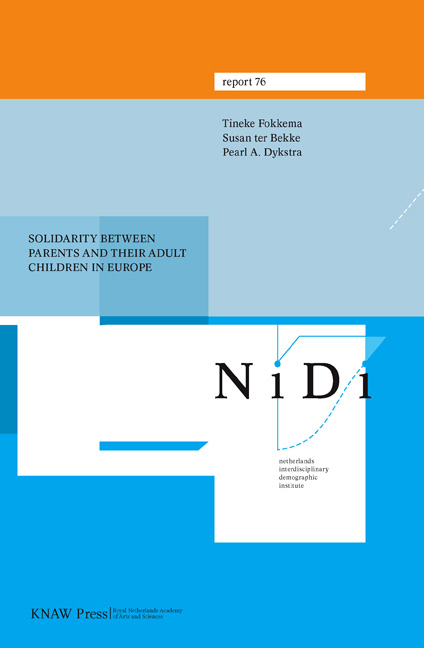Book contents
- Frontmatter
- Contents
- List of Figures
- List of Tables
- Executive Summary
- Acknowledgement
- 1 Introduction
- 2 Geographical Proximity
- 3 Contacts
- 4 Family Care Obligations
- 5 Support Exchange
- 6 Typology of Late-Life Families
- 7 Conclusion and Discussion
- References
- Appendix Measurement of the Independent Variables
- List of NIDI Reports
2 - Geographical Proximity
Published online by Cambridge University Press: 20 January 2021
- Frontmatter
- Contents
- List of Figures
- List of Tables
- Executive Summary
- Acknowledgement
- 1 Introduction
- 2 Geographical Proximity
- 3 Contacts
- 4 Family Care Obligations
- 5 Support Exchange
- 6 Typology of Late-Life Families
- 7 Conclusion and Discussion
- References
- Appendix Measurement of the Independent Variables
- List of NIDI Reports
Summary
Introduction
The relevance of examining geographical proximity between parents and their adult children is twofold: it is an important indicator of intergenerational relationships and one of the main preconditions for other dimensions of solidarity. Living nearby facilitates contact and support exchange. This applies in particular to face-to-face contact and practical help (De Jong Gierveld & Fokkema, 1998; Hank, 2007; Joseph & Hallman, 1998; Lawton et al., 1994a; Litwak & Kulis, 1987; Tomassini et al., 2003).
In this chapter we will address the variation in geographical proximity between parents and their adult children across European countries and individuals. SHARE respondents were asked about the geographical distance of all children (up to 17). The answer categories were: (1) in the same household, (2) in the same building, (3) less than 1 kilometre away (4) between 1 and 5 kilometres away, (5) between 5 and 25 kilometres away, (6) between 25 and 100 kilometres away, (7) between 100 and 500 kilometres away, (8) more than 500 kilometres away, and (9) more than 500 kilometres away in another country. As coresidence can be seen as a form of solidarity, we will first present betweencountry differences for all older parents, including those with coresident children (figure 2.1). Next, we will focus on those who only have non-coresident children. Besides differences between countries, descriptive statistics will be given of the association between several parent characteristics and two indicators of geographical proximity: the average number of children living within five kilometres and the percentage of parents with at least one child within five kilometres (table 2.2 and table 2.1). In addition, we will present the results of the logistic regression analysis on geographical proximity, where having at least one adult child within five kilometres (1 = yes; 0 = no) will be the dependent variable (table 2.3). These regression results allow us to evaluate the extent to which the between-country differences and the associations with the personal characteristics remain significant after controlling for the influence of the other determinants in the model.
Multi-generation household: a southern European phenomenon
The most striking finding presented in figure 2.1 is that southern European older adults were far more likely to form part of a multi-generation household than their peers in central and northern Europe.
- Type
- Chapter
- Information
- Publisher: Amsterdam University PressPrint publication year: 2008



